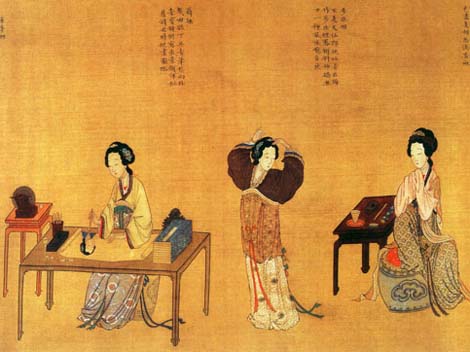
Feminine beauty has been celebrated over the centuries in China and the perception is ever-evolving, but an enduring beauty standard is as follows: a rosy plump oval face, new-moon-shaped eyebrows, delicate and soft limbs and fingers, and fine porcelain skin. More than skin deep, a Chinese beauty should also have good manners, temperament, tastes, and style of conversation.
Perfect Facial Features

Face
It is long held in Chinese ancient painting theory that an oval face makes for the best proportioned features.
According to this theory, the face can be transversely divided into trisections, or "Three Stops" - from the hairline to the eyebrow, from the eyebrow to the bottom of the nose, and from the bottom of the nose to the bottom of the chin. Vertically, the face can be divided into quinti-sections or "Five Eyes"- the distance between two eyes shall be the length of one eye, and the vertical distance between the outer canthus and the external opening of the ear shall be also the length of one eye. In addition, sweet dimples in the cheeks, or Jiuwo, literally a pit of wines in Chinese, are definitely a plus for female charm.
Eyebrows
Chinese people believe that the eyes and eyebrows of a woman can speak her mind.Shapes of eyebrows varied in different dynasties. In the Qin Dynasty (221-207 B.C.), long, bushy and curved eyebrows were in vogue while the following Han Dynasty adored shaped eyebrows. Tang women loved to trim their eyebrows into the shape of the half moon or arched willow leaves. Thin, long and slightly curved eyebrows have been the major trend since the mid-14th century.
Eyes
Chinese poets often compare beautiful women to peach blossoms in spring. The eyes are long and slightly upcurved at the corners. Under the eyelashes is a pair of misty black pupils.
Lips
Chinese people adore a small, rosy, glossy, and gently up-curved mouth, the so-called "Cherry-like-little Mouth."
Timeless Appeal of Slender Waist
The traditional Chinese theory of beauty says that a slender waist and a small waist-to-hip ratio are vital for feminine beauty. The "belle curve" showcases the softness and tenderness of women, fitting in with the aesthetic tastes of Chinese. .
In ancient China a girl with an hourglass-shaped waist made for the perfect figure. Many ancient poems and legends have linked attractiveness with a thin waist. A legend dating to more than 2,000 year ago says that the King of Chu States lusted for narrow waists, leading to starving palace ladies. The Chu Waist was hence added into the vocabulary referring to a slender waist.
An Oriental Sexy Idol
What made a sexy idol for the ancient Chinese? Firm, uplifted buttocks and big breasts may not be the best answer. Instead, the Chinese thought the sexiest part of a woman was her eyebrows which, as mentioned before, were the coverts of her feelings, leading to its name "Rainbows of Affection." A protruding collarbone and a long, elegant neck were also the focus of secondary erogenous zones in China.
Science of Romance
In fact, beauty was not only a matter of physical appearance, but more importantly, as the painting had indicated, was a demand of feudal etiquettes, to be exact, the three obedience and four virtues."

Women's appearance, along with their impeccable morality, proper speech, and diligent housework, were compulsory criteria of good women. In addition, a woman should be obedient to her father before marriage, to her husband after marriage and to her son after her husband's death.
Music
Music refers to the qin (a kind of seven-stringed plucked instrument, similar to a zither) that has a more than 3,000 year history. It was required that every scholar learn the instrument.
Chess
Chess refers to encirclement chess. The ancient women had no chance to do the same work as men. So they gathered and played chess to relax.
Calligraphy and Literature
Writing calligraphy and poems was not the privilege of men. Women learned how to read, write and calligraphy no matter what their family background. They read to improve themselves, wrote poems to record their feelings and life, and did calligraphy for enjoyment.
Painting
There were many women who had a talent for painting in ancient times, though their skill was often overlooked in the male-dominated society of that time. The theme of their paintings usually related to flowers, little pets and beautiful women.
Needlework
Needlework is the symbol of diligent women and reflects female emotion and intelligence. It is also the standard of being a good wife.
It is a custom that has lasted to the present time. Women in the old days often made needlework for their lovers, while modern girls like to make gifts such as scarfs and cross-stitch embroidery.





